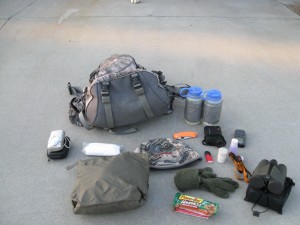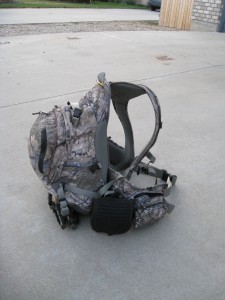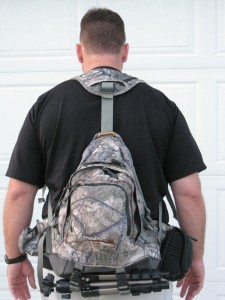Lose the Boat Anchor You Call a Day Pack
Let me start by saying this….my current hunting partner is truly as good a guy as you will ever meet. I would take a beating for him in a hot minute for all the times and ways he has been there for me during the last 10 years of hunting together. Now that I’ve publicly stated my man-love for him, I’ll recount the first time I picked up his pack, slipped a disc in my back, and realized what a TOTAL moron he was.
It was our first day of elk hunting together, and we were already a good three miles from the road. This road by the way,
is/was the only one for MANY miles. We were hunting off of the lone road sandwiched between the Frank Church and Bitterrot-Selway Wilderness areas. I’m not kidding when I say we were a good 50 miles from the nearest form of civilization. Anyway, when I dropped his pack I heard something jingle. When I tore open the pack to investigate, I found almost FIVE DOLLARS IN QUARTERS totaling approximately 30 pounds.
When I inquired as to why that might be, he stated that they were necessary,…. “in case he got lost and stumbled across a pay phone“.
I told him that,
(a) Payphones disappeared during the Jurassic period, and
(b) If he got lost in this country no one but the mortician would need contacted.
I’m glad to report the idiot I discovered on the mountain that day has since been replaced with a lean, mean elk-killing machine that does NOT take piggy-banks with him everywhere he goes.
Now I’ll admit up front that the best 10 pounds you can lose is that of your own body weight. Humans haven’t built any gear yet that weighs less than nothing, and the body-weight you shed in preparation of elk season WILL translate to a better odds of success. Now that we’ve acknowledged that fact, let’s move on to where we can help ourselves in terms of gear…specifically what we carry in our packs every day.
Hunting packs are often like security blankets….we drag them EVERYWHERE, but seldom do they serve a purpose. To be sure, we dig into them from time to time to retrieve water and the occasional snack, but the vast majority of the time the contents go largely ignored..until we harvest something of course.
In an average elk-hunting day where you climb a mere 2,000 feet of elevation, the difference between a 10 pound pack and a 20 pound pack can be amazing. While some of you sadists may enjoy the type of self-punishment a heavy pack provides, I’d rather expend my energy on climbing one more ridge to see what’s on the other side.
Let’s start with the pack itself. Anything more than 2,000 cubic inches of storage for a day pack is excessive. For many years I got by on a Blacks Creek Guide Gear fanny pack that was only 1,100 cubic inches. From there, I graduated to a Badlands 2,200. When I figured out that was too much, I switched to a Badlands Ultra Day that had the right amount of space and weight, but just flat sucked in terms of usefulness and comfort. These days, I’m running a 1,400 cubic inch Sitka Gear Ascent that seems perfect with respect to volume, comfort, and weight.
There were many things I liked about the previous packs I’ve used, but almost all of them were excessively heavy. The Badlands 2,200 for instance, weighs 4.1 pounds without putting a thing in it. The Sitka Gear Ascent weighs 1.5. I would argue that both are good packs, but I know which of the two I’d rather drag up and down steep mountains. To put the 2.6 pounds of difference into perspective, that is more than my spotting scope weighs….which by the way, still fits in to my Ascent with all of the other gear I always take with me.
I’d say there are a LOT of really good day-packs out there if you’re not doing anything more than walking to your tree-stand in the south to hunt whitetails. For hunting elk out west in the mountains though, MOST packs are far heavier than they need to be. I realize of course the Ascent is a smaller pack, but that’s the whole point of this article. You don’t NEED as big of a pack as you think you do.
The following is a list of what I carry in my day pack regardless of the terrain, weather, or species I’m hunting…
Small Bic lighter waterproofed with electrical tape, cotton balls inside a film canister covered in petroleum jelly for fire starting material, Iodine tablets for water purification, Blade Tech folding knife that weighs 2 ounces, Leica CRF 900 rangefinder, wind checker, two 16 oz. Nalgene wide-mouth watter bottles wrapped in 550 cord, two energy bars, Patagoni “Puff Ball” vest, Sitke Gear Celcious hat, thin wool gloves (cheap, surplus military liners), Garmin eTrex Geko, 8×32 Meopta binos, toilet paper, license/tags, 1 ounce Atom headlight, and a small camera.
The following is a picture of my pack, and all of the “essentials” I just referenced, laid out next to it.

Let me be clear that all of these things EASILY fit in my pack. As mentioned, there is even enough room leftover to throw in my Leupold Gold Ring HD Spotter should the occassion call for it.If it’s colder or the weather is questionable at ALL, I throw in my set of Sitka Nimbus raingear.
Here is the “essentials”, AND the spotter, tripod, and the aforementioned raingear all loaded in the pack.

And finally, here is an absolute SPECIMEN of a man wearing said pack for frame of reference.

These clothing items along with the Cabelas Microtexbottoms, Sitka Core top, and Sitka 90 % jacket I generally wear, will allow me to hunt everything from 20-90 degrees in relative comfort.
I know what you’re thinking….”What about the meat saw, game bags, pack frame, blah, blah, blah, ” All of that stuff stays at camp partner. Yes it would be nice to have at hand when your successful, but it isn’t necessary. A knife alone will allow you to quarter an elk via the “boneless” method. You can hang the meat with the 550 cord wrapped around your water bottles to cool it during early season hunts. Everything else can be retrieved when you get back to camp.
There is no need for a “wasted” trip either. Even the lightweight Ascent pack I use, was capable of hauling out a front shoulder on an decent little 4-pointer muley I shot last year….and was with EVERYTHING else I already mentioned. I had to get creative on how and where I lashed the quarter, but it worked just fine.
To some of you the spartan approach I take in association with my daypack is nothing short of blasphemy. While it may not make for a “comfortable” stopover, I could survive most anywhere in the world on the items I keep in my pack for days on end. Considering how much I have to haul up and down the mountain with my own wide butt, the relative ease a light pack provides is welcome relief.
So there you have it. There is more than one way to skin a cat (or chase an elk), but this one has proved to work wonders for me. I expect each of you will have slight variations to the pack list I’ve included. The point of all this is to learn to differentiate between what you WANT, and what you NEED.
There are a lot of good packs out there I suppose, but experience tells me the Ascent is the reigning king for day hunts in the steep and nasty. If you just HAVE to bring the kitchen sink with you, the new Sitka Gear Flash 20 would be my second choice as it offers 2,000 cubic inches and only weighs 3.1 lbs.. For that matter, I can give the same reccomendation to ALL of the gear I mentioned. Each item in there has proven itself to me in the most rugged mountains Idaho has to offer. I’m always looking for even the slightest advantage in gear, so any improvements you can see would be welcome council.
Remember, all of the stuff you’ve left behind will allow you to hunt harder in the first place. That “saved” energy may very well be the difference in whether or not you’re able to get in front of the bull you previously spotted heading for the ridge-top saddle.
Shoot straight and thanks for taking the time to read my post.
Dave Claycomb
